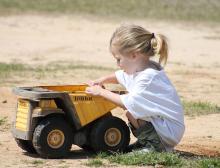
Solitary play, also known as independent play, is one of the earliest stages of play where children play alone because they have not developed socially to be able to play with others yet or because they choose alone time.
In 1932, sociologist Mildred Parten, at the University of Minnesota’s Institute of Child Development, developed a system for classifying participation in play by children that has been widely accepted. Her six stages were unoccupied play, solitary play, onlooker play, parallel play, associative play, and cooperative play. Her theory was that as children grew older with improved communication skills and more opportunities for interaction with other children, their solitary play would become more social.1
Children learn about their world and how to interact with others through play. Initially, babies spend much of their time in solitary play exploring all aspects of their environment. They manipulate objects and engage in symbolic play becoming familiar with objects, actions, and ideas. As they become toddlers, their mobility opens them up to more social exposure.2
Learning to play alone gives children the time to think and explore how their world operates. It gives them the freedom to use their imaginations. They are able to make their own rules for play and can become fully engaged in an activity that interests them.3 Playing alone promotes a sense of initiative, whether they choose to play with building blocks, dolls, animal figures, or other toys. Solitary play helps develop their creativity and the powers of concentration, persistence, and completion.4
Playing together with others develops at around age three or four; however, solitary play does not disappear. Even though children have developed socially to be able to play well with other children, there are times when they will want to play alone. For older children, solitary play is often educational, especially when manipulating objects in constructive play, which helps develop their abstract thinking.
Children’s play on playgrounds offers many opportunities for solitary play. Swinging, climbing, and sliding tend to be solitary activities, even though they may need to cooperate with others in taking turns, while not actually playing with one another. Active solitary play can contribute to the many benefits of being physically active as well as developing their motor skills, coordination, and confidence.
Some may have a desire to play with others, but feel insecure around children they don’t know. This is sometimes called reticent play due to the child’s reluctance to join in. This reluctance could stem from a variety of reasons. It could be considered a sign of anxiety as a result of bullying. They might experience shyness, especially in new situations. Children might also have poor social skills because of language problems or a limited understanding of others, such as those seen with autism and other developmental disorders.5
- 1. Tomlin, Carolyn R. “Play: A Historical Review.” EarlychildhoodNEWS. < http://www.earlychildhoodnews.com/earlychildhood/article_view.aspx?ArticleID=618 > 9 June 2016.
- 2. “Parallel Play in an 18 Months Old.” World Of Moms. < http://www.worldofmoms.com/articles/parallel-play-in-an-18-months-old/3672/2 > 9 June 2016.
- 3. “Playing alone.” National Toy Council. British Toys & Hobby Association. < http://www.btha.co.uk/wp-content/uploads/2012/10/Playing-alone.pdf > 17 Oct. 2016.
- 4. Olsen-Harbich, Nancy. “Playing Alone Can Promote Creativity, Initiative, and Esteem.” Cornell University. < https://blogs.cornell.edu/ccesuffolkfhw/2015/03/28/playing-alone-can-promote-creativity-initiative-and-esteem/ > 17 Oct. 2016.
- 5. Op. cit., “Playing alone.”

